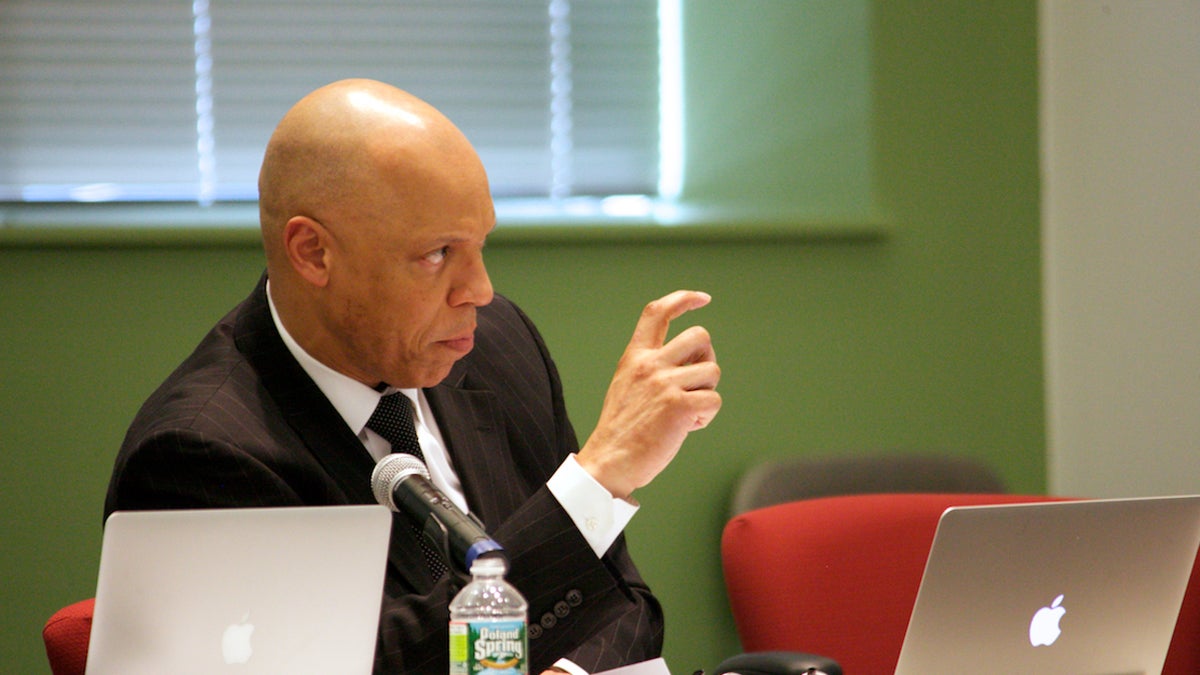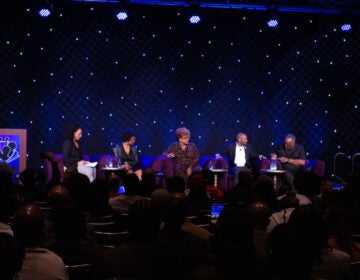Philly school district nearing new accountability rules for charters

William R. Hite, Jr., Ed.D, Superintendent of The School District of Philadelphia (Nathaniel Hamilton/for WHYY)
The School District of Philadelphia has a new tool for evaluating its charter schools, one it hopes will help end a long and public tug of war with the city’s growing charter sector.
If charters accept the terms in this revamped rubric — known as the “charter school performance framework” — the district will have a clear and mutually agreeable roadmap for deciding whether a school should close when its term expires or remain open for another five years.
If charters blanch at the deal, the incoming school board will inherit a dispute fraught with political implications and real-world consequences for tens of thousands of kids.
Seventeen charter schools that were offered renewals in the past have refused to sign new agreements based on disputes with the district’s expectations. These breakaway charters have now gone more than a year without valid contracts, and say they won’t sign agreements they see as overbearing and unrealistic. The prolonged disagreement has exposed tensions between the District’s charter office and the growing sector it oversees.
Another 16 charters are recommended for renewal again this year, meaning there are now 33 total schools potentially in limbo — roughly 40 percent of the city’s 84 charter schools.
The new tool is an attempt to break this stalemate, and was developed with substantial input from the charter operators themselves. District leaders say it is far more transparent and consistent about what schools must do to meet district standards in academics, operations, and financial stability. They also hope it will create an ever-increasing academic bar for charters, one that ensures these publicly financed, privately run schools are superior to their district counterparts and worth the financial onus they place on the system as a whole.
In that spirit, the standard charter agreement has undergone “more than 60 negotiated changes” over the past year, according to Estelle Richman, chair of the soon-to-be dissolved School Reform Commission.
“These charter agreements incorporate a revised performance framework which provides charter schools with transparent and predictable accountability and ensures charter schools are quality options for students and families,” she said in a statement.
For instance, the performance framework no longer includes special admissions magnet schools in peer groups when determining whether a charter has out-performed schools with similar demographics. The district also says it will circulate a calculator that charters can use to determine how they’re faring on the rubric well before their five-year contracts come up for renewal, adding clarity to the process.
The question now is how many charters will agree to the new terms.
Officials representing 57 charter schools have been working closely with district counterparts over the last month to reach a final deal said Scott Gordon, head of the city’s largest charter network, Mastery Charter Schools.
“We’ve been working to get a mistake-free agreement and I’m really happy that we’re almost there,” said Gordon, who operates five schools without contracts has another two up for renewal this year. “I think it demonstrates that these are not unsolvable problems.”
A battle over cut scores
The coalition, however, still has concerns, Gordon added. And there are rumblings that many charters will continue to hold out.
In particular, the schools think the academic bar is unfairly high and will result in above-average charters getting axed. Although district officials described the new framework as a final offer to the charter sector, charter officials hope there is more room for negotiation.
“We are interested in getting this done and signing and setting a high standard,” Gordon said.
The new evaluation tool has three branches: organizational compliance, financial health, and academic success — which holds the most weight.
As the framework currently stands, a charter must earn 45 percent of all possible points in the academic column order to avoid a “does not meet” standards label, which would put the school at increased risk for a nonrenewal recommendation.
There is general concern among charter officials and advocates that the 45 percent threshold is too high, and that schools with lower scores should be spared the “does not meet” standards label. Others worry the district’s method of assigning points unfairly penalizes schools serving a higher portion of students that traditionally fare worse on standardized tests.
Within the academic success domain, charters can receive points for overall student proficiency, student growth, and attendance. Within the proficiency column, charters receive points for exceeding the average district test scores and exceeding the average of a group of demographically “similar schools.”
Jennifer Faustman, CEO of the Belmont Charter Network, says it’s unfair to compare some schools to the district average, especially in cases where charters took over poor-performing district schools. Faustman’s organization operates one such school, Belmont Elementary Charter School in West Philadelphia.
“You’re basically being challenged to exceed the district,” she said. “It has to be exceed, not equal.”
The last district-charter conversion occurred in 2016, and right now officials say they are reviewing the program. The turnaround initiative was designed to produce marked improvements in long-struggling neighborhood schools.
Despite protestations from some in the charter sector, district officials believe the new rubric is fair.
They note, for example, that a charter school could receive zero proficiency points and still earn a 45 percent academic grade as long as it earned three-quarters of available points in the attendance and growth columns. In other words, if students at a turnaround school weren’t proficient, by any measure, the school could still remain open by demonstrating above-average growth and attendance.
But the coalition of charter schools believes 40 percent would be a more fair number.
A charter could, theoretically, outperform its peer group for most of its charter term and still wind up with a score less than 45 percent if it failed to do better than the overall district average, according to Mastery’s Scott Gordon. The current framework would result in about one-fifth of all charters being labeled as academically deficient, according to Mastery’s math, Gordon said.
A 40 percent threshold, he said, would ensure no charters consistently performing in the top halves of their peer groups could be considered academically deficient.
Gordon called the 40 percent benchmark a “high standard” that would get higher with time as the district weeds out poor-performing schools.
“We are advocating for a standard that’s higher than the standard for district schools and we stand 100 percent by that,” Gordon said.
Mastery would also like to see the district use median scores instead of mean scores when determining whether a school has outperformed the district or its peer group. A median mark, Gordon argued, would ensure there are always 50 percent of schools above average and 50 percent of schools below.
Because there are some outlier schools in Philadelphia — many of them magnet schools — the district’s mean scores can be higher than its median scores, Gordon said. Across the district, mean test scores are three-to-five percentage points higher than median test scores in reading and math, according to a Mastery analysis.
A recurring clash
This isn’t the only area where charters have clashed with the district. A public feud broke out earlier this year when a coalition of charters opposed the implementation of a new board policy on when and how charters could be amended before renewal. The charters saw the process as an overreach. And it’s customary for charter closing decisions to be met by loud protests and calls of incompetence. In general, those in the sector grumble that similarly low-performing district schools remain open.
Charters can continue to operate even after their five-year agreements expire, which means the holdout charters have little immediate pressure to compromise with district officials. Eventually, though, charters operating under lapsed agreements could struggle to secure leases and loans, hampering their ability to function.
Adding to the uncertainty is the fact the SRC will soon be replaced by a local school board that could keep this new performance rubric in place or scrap it. It’s difficult at this point to handicap whether the new board would give more ground to the charter sector or raise the bar higher..
That political calculus will likely factor into what each of the 34 eligible charters decided to do before the June 21st SRC meeting.
Editor’s note: This article has been updated to reflect that 16 charter schools are recommended for renewal again this year, leaving 33 in limbo.
WHYY is your source for fact-based, in-depth journalism and information. As a nonprofit organization, we rely on financial support from readers like you. Please give today.





